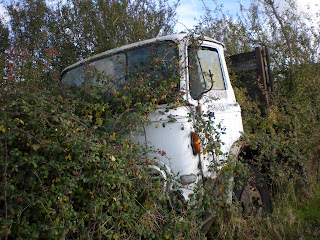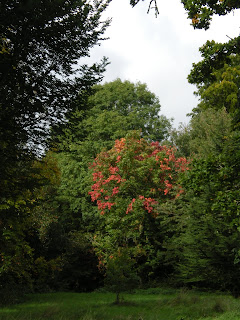Last week it was a soul-warming 25 degrees where we were holidaying in the Vaucluse. They've had little or no rain down there for months: the rivers are dry when they shouldn't be. As I set out to walk the weather's fair in Eydon but the temperature's down by eleven points and it's a bit cool around the knees.
I like walking in shorts, although the risks of the tick-borne Lyme's Disease - about which I've written before - are increasing. Matt Dawson, the one time Saints and England scrum-half was a recent victim, and a more resilient individual it's hard to imagine. I'm of the age when 'short trousers' were the established male mode of dress for school or leisure until at least the age of twelve. The transition into 'longs' was a pubertal rite of passage, slightly weird to our contemporary way of thinking. I wonder to myself whether my fondness for shorts is regressive behaviour -infantilism - and then start to contemplate the New Testament contrast between accepting the Kingdom of God 'as a child' and the labyrinthine twists and turns of intellect-defeating Pauline theology. Transactional Analysis has it that most of us still play at being both children and adults depending on any particular relationship or encounter and the side we get out of bed in the morning. I suppose as a Christian I can identify with that. Sometimes I display the petulance of a spoiled child to God, and sometimes, Him and me, we're best adult-to-adult buddies. Is either completely appropriate?
Down the bottom of the hill near the stream, the bridleway becomes very muddy indeed, and I slipslide along it holding the fence, trying not to hate horsey people. Tolerance and compromise are required in the countryside as everywhere else. I didn't hear very much of those qualities from the mouth of Andrew Gillett of the Country Land and Business Association on BBC's Countryfile last Sunday. The problem he was addressing is real and painful enough. Every year many farmers suffer financial loss and emotional turmoil when their sheep and cattle are attacked and sometimes killed by uncontrolled dogs. Most walkers will be able to cite supporting evidence for the claim that a minority of dog-owners are blind to the less attractive nature of their pets, and take insufficient measures to restrain them. Gillett's solution (he's a lawyer) is that farmers should be able to ban walkers from long-established rights of way for substantial periods of time. It's a Trojan Horse, folks. This is a lobby for those who would wish to permanently exclude all of us, whether we have dogs or not, from places we have an ancient right to be. I hope Members of Parliament listen politely and say 'no'. I've written to Angela Smith M.P., one of those being lobbied, expressing that hope. Perhaps others will do the same.
The Macmillan Way becomes rather vague as I head towards Moreton Pinkney. Two late teenage girls are bouncing around the old railway embankment in a 4x4. I say that I've missed my path, and ask if they know where it might have gone. They look at me as if I've dropped in from Planet Stupid: they obviously haven't the foggiest what a 'long distance footpath' is, although they're locals. I clamber down through the embankment thicket and locate a lane which turns out to be the right route. Again, I'm afraid one has to suspect that a landowner has wilfully removed signs. On a 'named' footpath. Disgraceful.
Morteon Pinkney is a straggly, green and pleasant village. Forty years ago, Stuart Marson used to celebrate it as a representative icon for the whole of Northamptonshire. He gave it its very own Blues. One of the verses referred to the perennial likelihood of the Cobblers, Northampton Town's football club, being relegated. Famously, the Cobblers are the only team who've ever gone from the bottom division of the Football League to the top division in successive seasons only to sink back whence they came with similar speed. They're currently in Division 2 (the old Division 3) and guess what? Yup, they're back in the relegation zone again.
I drop in on old friend Jane, but she answers the door looking very poorly. Jane's a teacher, and she's made it to half-term only to succumb to the 'flu. We swap greetings at arm's length on her doorstep, and I go off to St. Mary's church to offer up a prayer for her recovery well before Sunday evening, so that she gets some proper holiday before returning to the fray. St. Mary's is a dinky little church with lots of interest. There's a nineteenth century clock on display with connections to a Canadian bishop of the time, a lovely piece of wall art recording donations to the church during the eighteenth century, and a Platonic quote by the organ console.
Amen. The church gate asks visitors to keep it shut because of grazing sheep, and indeed you can walk straight into the fields beyond via a kissing gate. Keeping your back to the church there's a lovely view of what I presume to be the Georgian Old Rectory. The touches of humour in a church building, the way its pews are polished, always speak to me of a community's character, and its feeling for the place of worship at its centre.
Across the fields on the other (north) side of the road is Canons Ashby, a National Trust property, which was in ruins until 1981, when Gervase Jackson-Stops pulled off a coup in seeing this Elizabethan manor house gloriously restored using government money. It's small but perfectly formed: a quiet architectural and horticultural pleasure. Over the far side is the Priory church, one of only four private Anglican churches in the country, or so it says inside. I'm not sure what this means. What I do know is that there was once an Augustinian foundation here until Henry VIII and his team pulled it to pieces, leaving the very truncated building we can visit today. Gervase is fittingly commemorated with a wall plaque.
As is the case with many NT properties at this time of year, much is being made at Canons Ashby of all things Hallowe'en. Pumpkins adorn every wall, and children, some of whom are far too old for this kind of stuff IMO anyway, scamper around dressed as witches warlocks, zombies and all the rest of their undead friends. I don't like it, though as 'Peter Simple's invention Dr Heinz Kiosk often used to remark in his long-running Daily Telegraph column, 'Ve are all guilty...'. I'm afraid I too have contributed a smidge to the broomstick industry, writing music to accompany audio books of Valerie Thomas and Korky Paul's 'Winnie the Witch'. Seeing the way fireworks, all purpose spookiness, Diwali, Disney etc. etc. have now combined into a rootless, new age, amorphous, autumn retail-fest, I repent. Apart from boosting the economy ( and would we do this at any moral cost?) what's any of it really about? Weston Favell has resounded to explosions of one sort or another every evening since October 23rd. Is it communal guilt that we aren't living in Aleppo?
Away from Canons Ashby to the north-west the countryside begins to feel increasingly remote - for Northamptonshire. I wind up a little valley to a bridleway and in time climb to the highest point on the ridge overlooking Woodford Halse. A kindly farmer hangs back from spraying his crop for a couple of minutes to let me pass - a nice courtesy. In the town I climb Scrivens Hill to find that St. Mary's church is swathed in scaffolding - major repairs - and that all services are being held in The Nest, a children's facility back down the hill. I know that The Nest has something to do with children because a few hundred metres on I'm hailed by Judy who tells me so. She's curious to know why I'm photographing the houses. Judy's the sacristan at St. Mary's and still holds a grudge against Henry VIII for what he did to Canons Ashby. I ask her how long she's been sacristan. Thirty-five years, she says, and I repress a smile. You'd have to be a fan of the BBC's ancient comedy show Round the Horne to understand why. A running gag in this 60's creation was Horne as BBC reporter interviewing a hoary-voiced local. 'How long have you been mowing the lawns/ringing the bells/dwile flunking/etc.' he would ask. 'Thir-ty five years!' would come the invariable answer. It was easier to get laughs in those days...
Is there a town of comparable size (max 3,500) more indebted than Woodford Halse to its railway past which today has no trains or track? I doubt it. It was once a four-way junction on the Great Central Line, the third way of Britain's north-south railways. Now what's left is a monumental pair of railway bridges, and between them the sad, bricked up entrance to the station which once stood there. There's a raised pocket park too, which follows the line of the 'permanent way', and rows of terraced houses for the one-time railway workers which was what Judy discovered me photographing. Chiltern Railways once had dreams of extending from Banbury to Leicester through here, but those sketchy plans were abandoned as late as 2012. New housing and lack of demand killed off any prospects. There was a substantial engine shed here once, visited regularly by the biggest of the post-war steam locomotives. All sheds had a code. Woodford Halse's was 1G, but I never made it this far as a (shorts-wearing!) sub-teenage loco spotter.
A thing I love about the late autumn is the quality of the light on a day like this, as beautiful as the most subtle stage illumination, casting a golden glow across grass and stone. And so it is as I cross to West Farndon on the Jurassic Way through a succession of sheep fields helpfully waymarked by a farmer with boards warning me that there's a bull on the loose. I haul myself up the incline back into Eydon and the day is book-ended by a pretty young woman on a bicycle. In the morning she'd smiled at me as I was putting on my boots by the tailgate of the car. We meet again at a gate, and she smiles again. 'You're brave', she says, indicating my bare legs and tee-shirted top. The sun has just set, and yes I suddenly think, it is rather chilly, isn't it. I return to the car, an old man foolishly affirmed by a brief encounter.
Scrawls on the wall: 19 km. Just under six hours. One piece of toffee-apple cake and two cups of Earl Grey courtesy of the N.T.. Three churches. 15 degrees C. and bracingly beautiful 12 stiles. 21 gates. 5 bridges.
Lord
When I misunderstand
Or am misunderstood,
Help me to see my fault.
Renew my ways of being;
Give me a kinder language;
A wider repertoire of mercy;
A more generous appreciation of difference.
So may I do my little part
In moving forward your Kingdom
Here on Earth
Amen.













